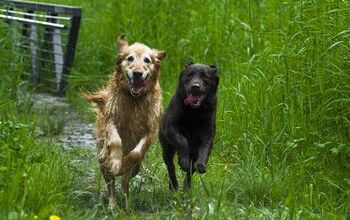How to Teach Your Dog to Speak


If your dog has a tendency to bark at anything and everything, teaching him to speak might seem counterproductive. The truth is, however, that you cannot teach your dog to stop barking on command unless you teach him to speak first. Fortunately, it is fairly easy to teach your dog to bark on command since it is a behavior that he displays naturally.
Steps to Teach Your Dog to Speak
The first thing you need to do in order to teach your dog to speak is to figure out what makes him bark – once you figure this out you can then use that to encourage your dog to speak and then reinforce that behavior with food rewards and praise. Many dogs bark when the doorbell rings so, in order to teach your dog to speak, you simply ring the doorbell and give your dog the “Speak” command when he barks. The best way to do this is to utilize clicker training – you click the clicker when your dog exhibits the desired behavior so he quickly learns what it is you are expecting of him.
Related: 6 Cool Tricks to Teach Your Dog
Here’s how to teach your dog to speak:
- Have a friend or family member stand outside your home on the other side of the front door.
- Stand inside the entryway with your dog – have a few treats in hand and more in your pocket.
- Have your friend ring the doorbell then wait for your dog to bark.
- When your dog barks, give him the “Speak” command and then click your clicker to identify the desired behavior.
- Immediately after clicking the clicker, give your dog a treat and praise him.
- Repeat this training sequence several times until your dog responds consistently by barking when the doorbell rings.
- Try giving your dog the “Speak” command without ringing the doorbell – if he responds correctly give him a reward.
Repeat the training sequence as needed until your dog gets the hang of it. If you are using a clicker, make sure you only use it the first few times until your dog learns which behavior it is you are targeting, then phase out the clicker but keep issuing the food rewards. If you find that your dog is having a hard time paying attention during the training sequence, ask him to “Sit” before your friend rings the doorbell so you know he will be paying attention to you.
Related: 6 Common Mistakes You’re Making When Training Your Dog
If your dog doesn’t bark often, or if he doesn’t bark at the doorbell, you may have to try another method. One way might be to act enthusiastic and hyper in order to get your dog excited – many dogs bark when they are excited. It might help to use one of your dog’s favorite toys or to play a game he enjoys.
Teaching Your Dog to Stop Barking
Once you’ve taught your dog to speak on command you can then teach him to stop barking on command. Go through the training sequence listed above and get your dog to bark with the “Speak” command. When your dog barks, praise him but do not give him the treat just yet. Give him the “Hush” or “Quiet” command and wait for him to stop barking. As soon as he does, click your clicker then praise and reward your dog. Repeat the training sequence until your dog gets the hang of it and then phase out the clicker.
No matter what you are trying to teach your dog, the key to success with dog training is consistency. Use the same commands each and every time and be consistent about rewarding your dog for responding appropriately – at least until he has a firm grasp on what you expect from him. Over time you can reduce the frequency of your food rewards and reward your dog with praise instead.

Kate Barrington is the loving owner of two cats (Bagel and Munchkin) and a noisy herd of guinea pigs. Having grown up with golden retrievers, Kate has a great deal of experience with dogs but labels herself a lover of all pets. Having received a Bachelor's degree in English, Kate has combined her love for pets and her passion for writing to create her own freelance writing business, specializing in the pet niche.
More by Kate Barrington























